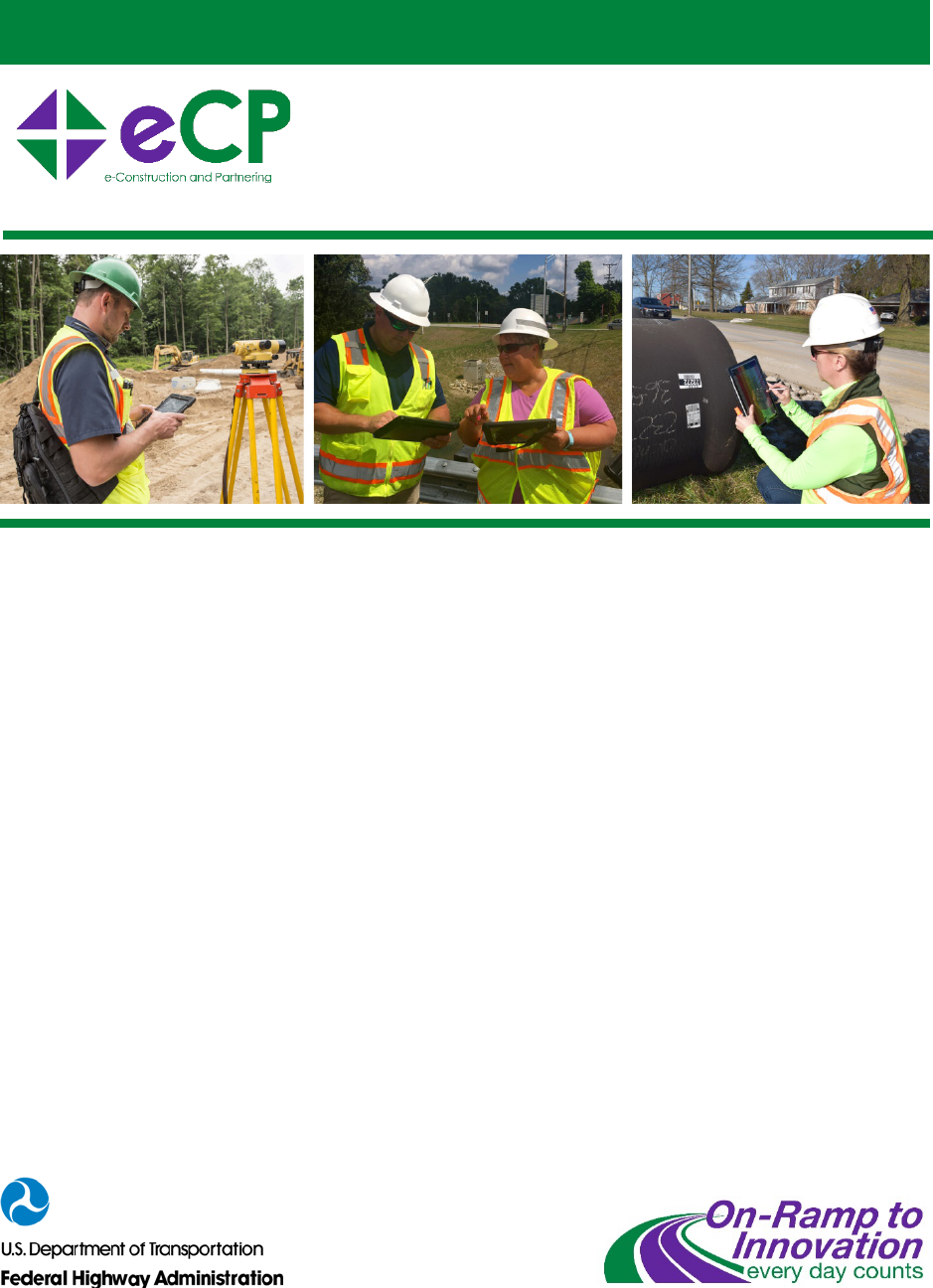
Peer-to-Peer Exchange
Arkansas and South Carolina
Departments of Transportation
Little Rock, Arkansas
June 13–14, 2018
Technology Brief
e-Construction and Partnering:
A Vision for the Future

FHWA e-Construction and Partnering Technology Brief
ii
Table of Contents
Background ..................................................................................................................... 1
Project Approach ............................................................................................................. 3
Workflow ......................................................................................................................... 4
Cost and Benefits ............................................................................................................ 7
Key Takeaways and Lessons Learned............................................................................ 7
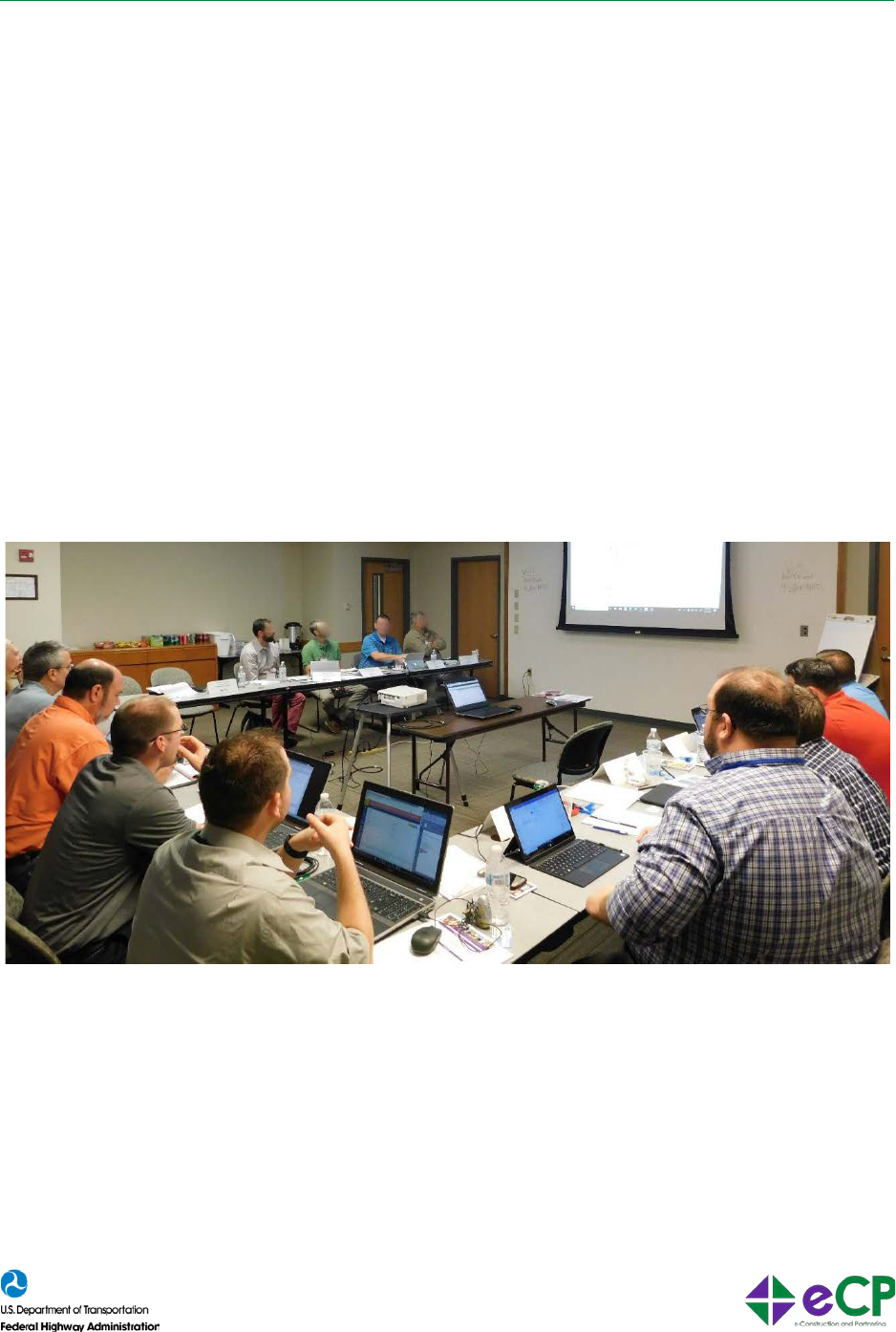
FHWA e-Construction and Partnering Technology Brief
1
Background
The South Carolina Department of Transportation (SCDOT) has implemented several
technologies to support its e-Construction and partnering initiatives, including use of
laptop computers and tablets for electronic daily reports and electronic document
management for contract administration and field operations. The SCDOT requested to
participate in a 2-day, face-to-face peer exchange with the Arkansas Department of
Transportation (ARDOT) to explore best practices and initiative improvement options.
The peer exchange, sponsored by the Federal Highway Administration (FHWA) as part
of the fourth round of the Every Day Counts (EDC-4) e-Construction and Partnering
(eCP) technical assistance program, was hosted by ARDOT on June 13–14, 2018. A
delegation of four SCDOT representatives traveled to Little Rock, AR, to meet with
several ARDOT representatives. FHWA staff from the Arkansas and South Carolina
Division Offices and the Resource Center were also present. The peer exchange
focused on best practices specific to implementation of electronic document
management for contract administration and field operations using tablets and various
software programs.
Figure 1. Photo. SCDOT and ARDOT peer exchange participants. Source: FHWA
The SCDOT and ARDOT e-Construction programs have many similarities. Both use the
American Association of State Highway and Transportation Officials’ AASHTOWare
Project SiteManager™ as their main construction management system and have
invested in Microsoft Windows® -based tablets, but there are also several differences.
ARDOT has heavily customized the Project SiteManager software by developing
agency-specific user input forms, known as SiteManager templates. The two agencies
selected different tablet hardware options. ARDOT selected the Dell™ Latitude™ 12
tablet and SCDOT chose the Microsoft® Surface® Pro 3 tablet with Wi-Fi hotspots.
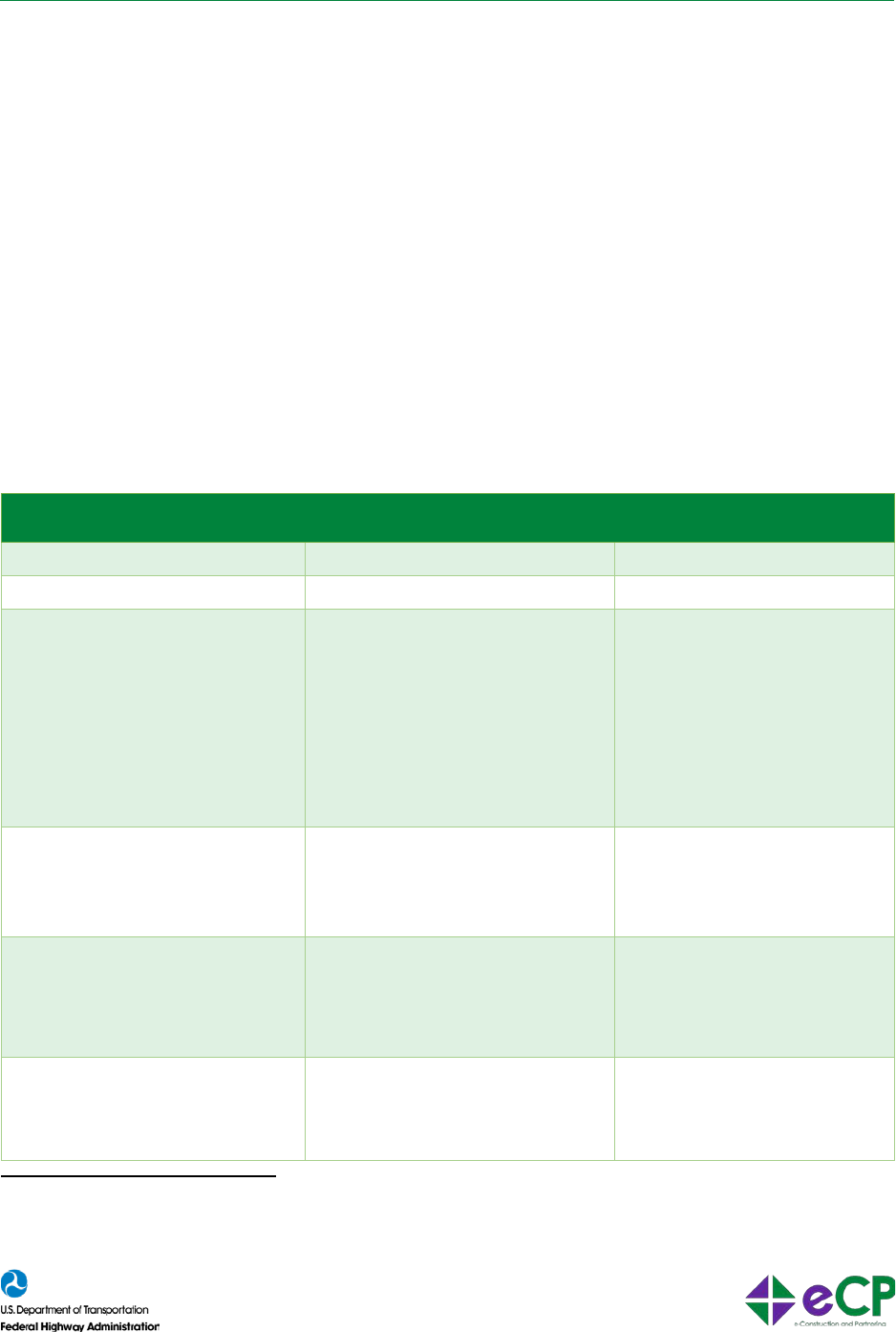
FHWA e-Construction and Partnering Technology Brief
2
The Dell Latitude 12 tablet includes the ability to install internal air cards and GPS
functionality. It also has several peripherals, such as a keyboard, stylus, and adapters
for Universal Serial Bus (USB) and Ethernet. Alternatively, the Microsoft Surface Pro 3
and Wi-Fi hotspots allow multiple field staff to share the same connection. Both
agencies are considering the tablets as possible laptop replacements in the future.
The two agencies differ the most in their approach to document management and
electronic signatures. ARDOT chose Doc Express™, a cloud-based system from
Info Tech®, to manage all documents throughout the life of the contract, starting in the
pre-construction stage. SCDOT leveraged its existing licenses for Microsoft®
SharePoint® and Bentley ProjectWise® for external and internal stakeholders,
respectively, to manage certain documents (i.e., standard forms).
Table 1 summarizes the technologies used by SCDOT and ARDOT in their
e-Construction programs.
Table 1. SCDOT and ARDOT e-Construction practices.
e-Construction Application Technology Used by SCDOT Technology Used by
ARDOT
Advertisement and bidding
Bid Express® Bid Express
Contract execution
Paper-based Doc Express
Electronic daily reporting,
estimates, and change
orders
AASHTOWare Project
SiteManager
Microsoft SharePoint-based
Extranet
Bentley ProjectWise
AASHTOWare Project
SiteManager
Custom-developed
SiteManager Access
Reporting System (SARS
1
)
and Change Order
Generation System
(COGS
2
)
Document management
Microsoft SharePoint-based
Extranet
Bentley ProjectWise
Doc Express (design-bid-
build)
e-Builder (design-build)
Devices for accessing
various systems
Standard-issue laptops and a
limited pool of tablets
(Microsoft Surface Pro 3) with
Wi-Fi hotspots
Standard-issue laptops or
Dell Latitude 12 tablets with
data plan
Pre-construction
collaboration for design-
build projects
Bluebeam® Revu® e-Builder®
1
SiteManager Access Reporting System.
2
Change Order Generating System.

FHWA e-Construction and Partnering Technology Brief
3
Project Approach
SCDOT and ARDOT are challenged with increasing demands and limited resources.
Both need to be innovative and efficient with construction management and oversight;
however, there are stark differences in what is driving their adoption of e-Construction
practices.
SCDOT adopted e-Construction practices to address a limited workforce capacity,
which resulted from an increasing construction program that nearly tripled in 2015.
Facing challenges to hire and keep construction staff, SCDOT relies on consultants to
provide construction engineering and inspection services and sometimes contract
management. When consulting partners started bringing e-Construction technologies to
the job sites, SCDOT was encouraged to provide the same tools for agency staff.
SCDOT leadership made e-Construction implementation a priority when they observed
how the technology was improving efficiencies with consultants, deploying
approximately 50 Surface Pro tablets to allow staff to access SiteManager. SCDOT
plans to improve electronic document management using Bentley ProjectWise and
Microsoft SharePoint, is investigating the use of Info Tech’s Mobile Inspector™ and
HeadLight™ by Pavia Systems, and is planning to upgrade to the Web-based version of
AASHTOWare Project Construction & Materials™ software.
ARDOT’s e-Construction philosophy is to make the original source of information
electronic, reduce or eliminate the need for printing, and streamline the document
approval process. ARDOT has practiced e-Construction management since 1999 via
the AASHTOWare Project SiteManager program and, in 2011, implemented the first
customization of electronic reporting.
ARDOT started piloting electronic bidding (Bid Express) in 2010 and mandated all
contracts be signed electronically in 2014. Electronic bidding has allowed the agency to
streamline the process and improve efficiency and transparency. Reports and analysis
of all bids are now produced automatically, and the results are posted on the ARDOT
website within minutes.
In 2015, ARDOT used State Transportation Innovation Council (STIC) funds to deploy
more than 60 tablets with air cards to access all its systems. This investment was
followed by the piloting of Doc Express, which became the agency’s official document
management system in 2016 for all design-bid-build projects.
ARDOT also assembled an e-Construction committee with FHWA, ARDOT, and
contractor representation to encourage an open dialog for continued improvement
through partnering. ARDOT envisions its e-Construction program evolving into an
“e-DOT” solution, providing enterprise-level digitization and automation that illustrates
the commitment of ARDOT leadership and the recognition of e-Construction
technologies’ value to the program. The e-DOT initiative will drive other areas of the
organization to implement paperless workflows.
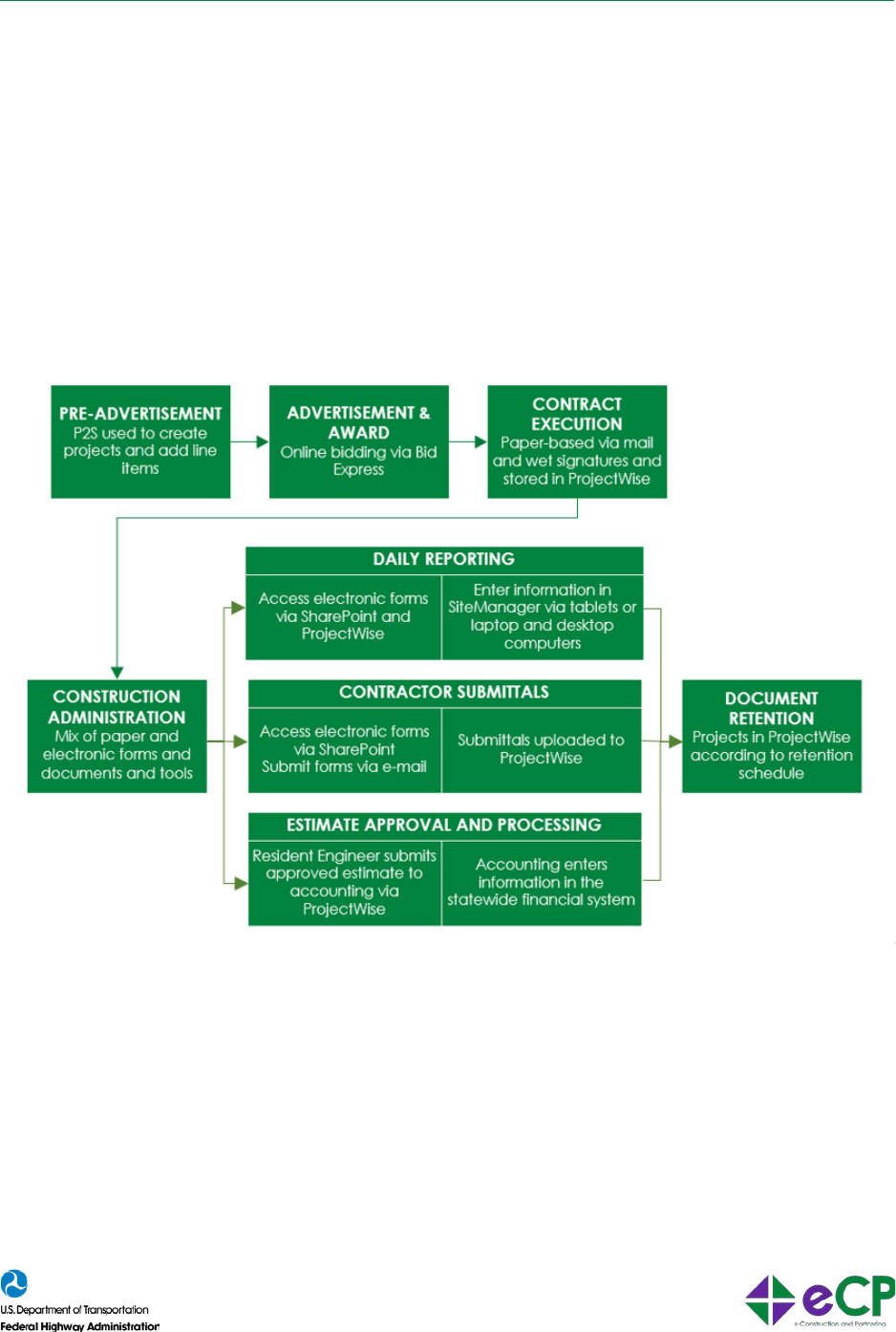
FHWA e-Construction and Partnering Technology Brief
4
Workflow
SCDOT construction management practices consist of electronic and paper-based
processes, which are illustrated in Figure 2. The custom-developed Project
Programming System (P2S) is used to create proposals, contracts, and pay item lists
that integrate with SiteManager. Projects are advertised online, and bids are accepted
electronically via Bid Express; however, the execution of projects is still paper based.
The contracts are mailed to the contractor and bonding company and, once executed,
they are scanned and loaded into ProjectWise. A paper copy goes to the field, and a
third copy goes to the contractor. The contract execution process takes about 30 days.
Figure 2. Flowchart. Overview of SCDOT construction management practices.
Contract administration and daily reporting is transitioning to an electronic workflow, but
SCDOT is currently using a combination of paper and electronic forms in SiteManager
for creating inspector daily work reports, estimates, and approvals for change orders.
Some staff enter information from the field through a virtual private network (VPN) or
VMWare® software. Security training is required before having access to the VMWare
software. Other inspectors prefer to write paper notes in the field and enter the data
when they return to the office.
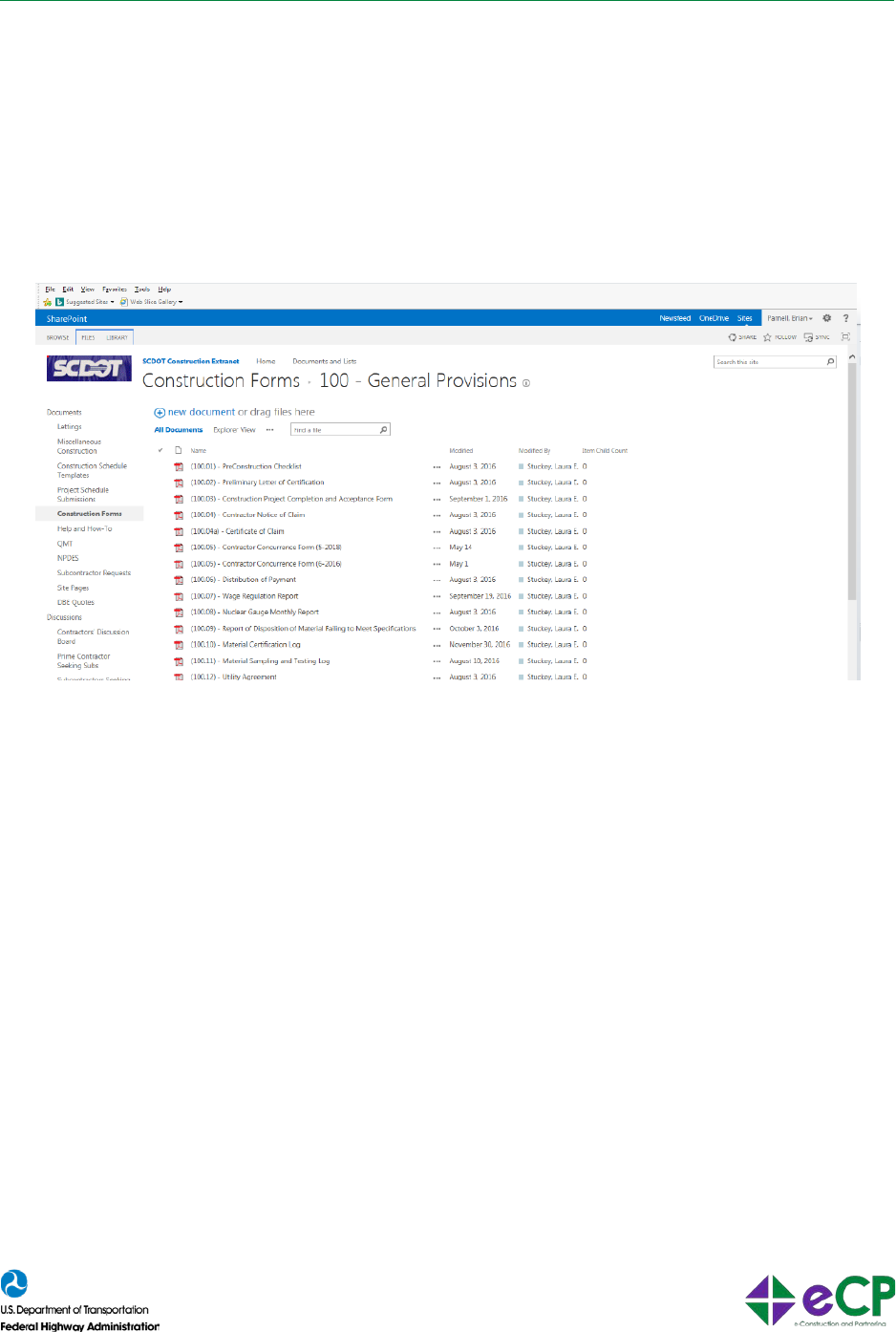
FHWA e-Construction and Partnering Technology Brief
5
Electronic forms used for documentation are accessible via SharePoint and organized
by specification section (Figure 3). Contractors download the forms and submit to
SCDOT via email. Forms are submitted via ProjectWise, where they are stored using a
folder structure, organized by county. Construction information is organized in
subfolders by contract identifier. When documents are added to ProjectWise folders, a
notification email is sent to a review committee. The project documents remain in
ProjectWise until the retention period expires.
Figure 3 Screenshot. SCDOT construction form masters on the Extranet. Source: SCDOT
The SCDOT workflow for processing estimates is also a combination of electronic and
paper-based methods. Estimates are sent to accounting through ProjectWise and
SharePoint. Some Resident Engineers (REs) affix wet signatures on estimates, while
others sign digitally using Adobe® signatures. The accounting staff then enter
information manually from the approved estimates into the statewide financial system.
ARDOT’s construction administration and daily reporting processes (Figure 4) are fully
digital, and field staff use tablets and laptops to capture data for their electronic daily
reports. Contracts are prepared using AASHTOWare Project Preconstruction, which are
then advertised online, and bids are only accepted electronically using Bid Express.
Upon award, the contract is executed electronically using Doc Express. Bid bonds must
still be printed and notarized before uploading them to the document management
system. Once a contract has been executed, all construction management is conducted
electronically via SiteManager, SARS, COGS, and Doc Express.
COGS and SARS are menu-based Microsoft Access® databases that ARDOT uses
during construction. COGS is used for generating, tracking and reporting change
orders, and SARS is used to query SiteManager daily report information to automate
reports for review and quality control audits. It required significant upfront development

FHWA e-Construction and Partnering Technology Brief
6
and implementation effort, but has since paid dividends with its granularity and
automation. Internal ARDOT auditors can use SARS to review data on demand.
SiteManager Administration staff can initiate automated audit checks that identify
deficiencies in reports and prevent viewing/approval until deficiencies are resolved.
Doc Express is ARDOT’s primary construction document management and digital
signature solution. There are predefined workflows for each contract that show what
stage the document is in in the workflow. These documents are signed electronically
using Doc Express role-based authentication workflows. Contracts can be signed and
executed within hours. Change order reports are created in COGS.
Change orders over $20,000 require wet signatures, so they are printed and mailed to
the contractor or sent via Doc Express. Supporting documentation (computer-aided
design [CAD] files, Microsoft Excel® spreadsheets, etc.) can be attached to the Portable
Document Form (PDF) cover letter submission as a supporting document, but each file
is limited to 200 megabytes in size. After construction is complete and the project is
closed-out, ARDOT locks the project files, and the service provider makes the files
available for 6 years.
Figure 4. Flowchart. ARDOT Daily Work Report process.
ARDOT also has an Online Ticket Tracking and Reporting System (OTTRS), which is
another custom solution developed by the agency. This solution interfaces with
SiteManager and the materials management system. It is designed to work offline for
inspectors entering information between loads. OTTRS creates reports on load
information and ticket information in an automated form.

FHWA e-Construction and Partnering Technology Brief
7
Cost and Benefits
The costs associated with SCDOT and ARDOT e-Construction activities include
purchasing the hardware, software, and subscription services plus the expended labor
for training, installation, troubleshooting, and system administration. ARDOT also
incurred the cost associated with the subscription of Doc Express and labor for support
staff. ARDOT negotiated an annual fee structure of about $125,000 per site license,
which allows for up to 500 active contracts. SiteManager was already owned by both
agencies, and SCDOT already owned an enterprise license of ProjectWise. Another
cost associated with e-Construction is the cost for the contractor to provide Internet
access at the project office per contract specifications.
While neither agency has quantified the benefits of its e-Construction investments, both
agreed that streamlining the payment process, reducing the travel time to and from the
office, and accelerating turnaround times for approvals are worth the investment.
Instead of taking days to get approvals, this process reduces the approval time to hours.
Also, SCDOT contract execution typically takes around 30 days to obtain the necessary
signatures and documents, whereas ARDOT typically executes a contract within 7 days
using the Doc Express system and associated automated workflows.
Key Takeaways and Lessons Learned
ARDOT noted several areas that will help realize success with e-Construction initiatives,
including bringing agency leadership on board, generating an understanding of both the
software and the need for innovation, securing management support, and committing to
fostering internal and external relationships.
While ARDOT committed to maximizing the capability of the SiteManager application
through the development of a wide array of templates for its Daily Work Reports and
materials, the upcoming implementation of AASHTOWare Project Construction &
Materials may not allow these templates to migrate. However, ARDOT intends to purge
templates not used or start fresh with a new strategy, taking lessons learned from the
legacy processes.
ARDOT cautioned about the potential expectation for immediate benefits from
implementing e-Construction innovations and for instant responses to inquiries given
the ability to generate reports and results quickly. People often forget the human
element to reviewing documents, validating results, thinking about implications, etc.
Thus, public perception of efficiencies may be unrealistic and likely require moderating
expectations.
Having a good partnering strategy with IT will help efforts to deploy tablets and maintain
devices be successful, and SCDOT noted that dual monitors are recommended for
using ProjectWise given the manual process to enter documents.

FHWA e-Construction and Partnering Technology Brief
8
Another key takeaway is that State Highway Agencies (SHA) could advance e-
Construction initiatives by getting buy-in or support from the respective FHWA division
offices to influence SHA leadership from a more objective perspective. Often, advocacy
for innovation and technology-enabled activities from external parties could benefit the
message being conveyed.
Table 2 Peer Exchange Participants’ Contact Information
Name Title Agency E-mail
David Henning State Construction Engineer ARDOT david.henning@ardot.gov
Jamey Wilhite Engineering Systems Administrator ARDOT lester.wilhite@ardot.gov
Jared Bymaster Systems Engineer ARDOT jared.bymaster@ardot.gov
Ben Browning Alternative Project Delivery
Director
ARDOT [email protected]
Clay Richter Road Construction Engineer SCDOT richtercw@scdot.org
Nick Waites Road Construction Engineer SCDOT waitesnt@scdot.org
Brian Parnell Construction Administration and
Technology Manager
SCDOT [email protected]
Matthew Shealy Resident Construction Engineer SCDOT shealymj@scdot.org
Rickele Gennie Operations Engineer FHWA -SC Division rickele.gennie@dot.gov
Brent Dather Transportation Engineer FHWA - AR Division brent.dather@dot.gov
Kat Weisner Construction & Contract
Administration Engineer
FHWA- Resource
Center
kathryn.weisner@dot.gov
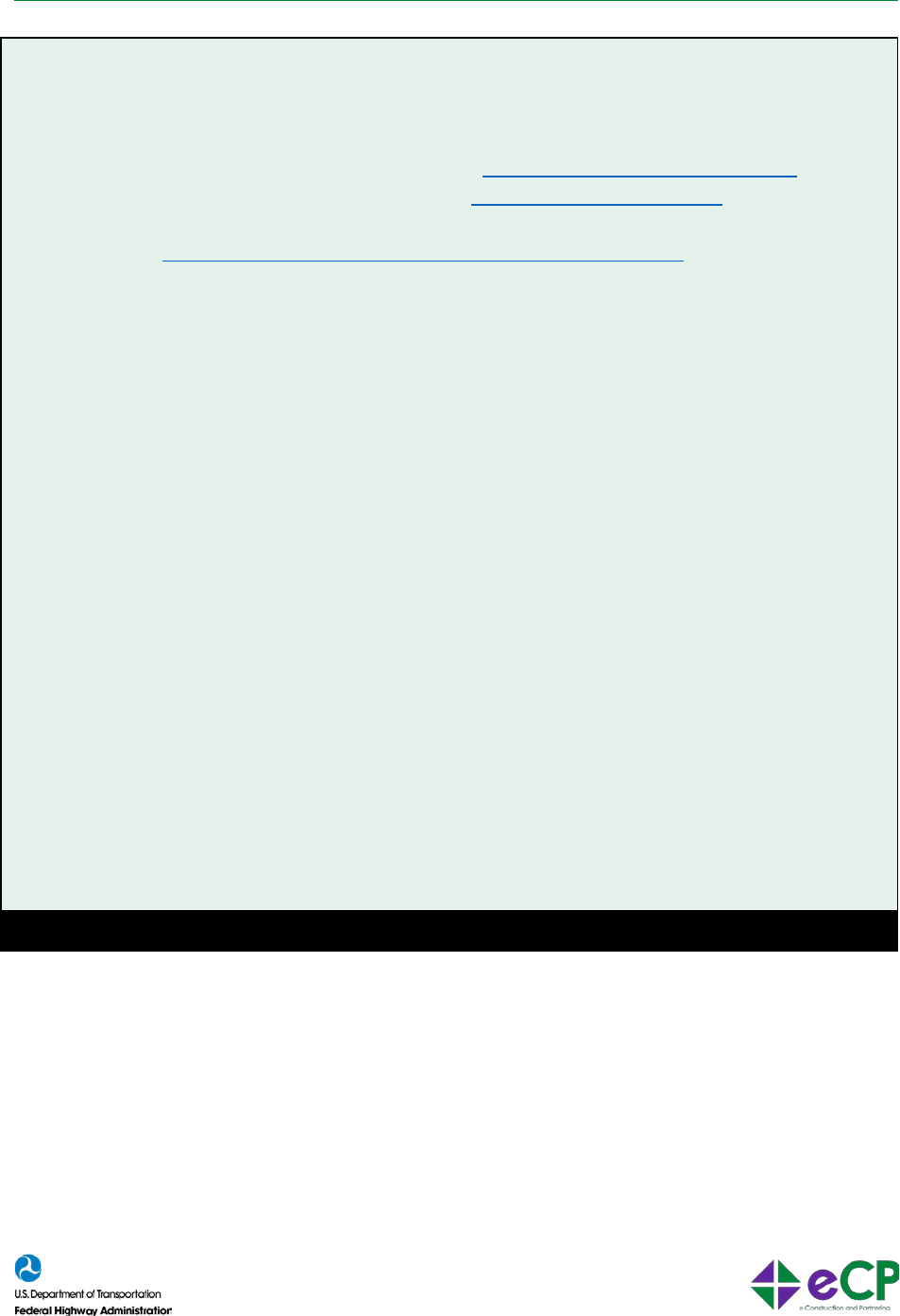
FHWA e-Construction and Partnering Technology Brief
9
e-Construction and Partnering: A Vision for the Future
Contact — For more information, contact:
Federal Highway Administration (FHWA)
Office of Infrastructure, Chris Schneider— christopher.schneider@dot.gov
FHWA Resource Center, Kat Weisner — kathryn.weisner@dot.gov
Federal Highway Administration e-Construction and Partnering innovation
resources https://www.fhwa.dot.gov/construction/econstruction
Distribution — This Technical Brief is being distributed according /to a standard
distribution. Direct distribution is being made to the Divisions and Resource
Center.
Key Words — e-Construction, construction partnering, paperless contracts, digital
signatures, document management, mobile devices, construction management.
Notice — This Technical Brief is disseminated under the sponsorship of the U.S.
Department of Transportation in the interest of information exchange. The U.S.
Government assumes no liability for the use of the information contained in this
document. The U.S. Government does not endorse products or manufacturers.
Trademarks or manufacturers’ names appear in this report only because they are
considered essential to the objective of the document.
Quality Assurance Statement — The Federal Highway Administration (FHWA)
provides high-quality information to serve Government, industry, and the public in
a manner that promotes public understanding. Standards and policies are used to
ensure and maximize the quality, objectivity, utility, and integrity of its information.
FHWA periodically reviews quality issues and adjusts its programs and processes
to ensure continuous quality improvement.
JUNE 2018 FHWA-HIF-18-052
